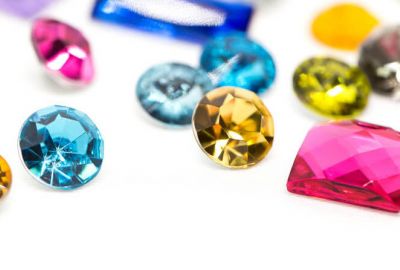Strass or Rhinestone

In the 18th century, Georg Friedrich Strass, an Alsatian jeweler, created an artificial crystal in the laboratory, with exceptional luster and transparency. He then colored the crystals, adding minerals to the alloy, while improving the luster and refraction of the finished stone by covering the back with thin 0.1 mm thick metal sheets. He it rhinestone, a stone of the river Rhine (German: Rhine) from the name of a popular crystal in the area. In Greece and in many European countries is used the name strass after the name of the creator.
Today, lead as an ingredient in the manufacture of glass and crystal in utensils (glasses, etc.) and rhinestones is not used. It has been replaced by barium oxide, zinc oxide and potassium oxide. In Gemology, but also as a marking of lead-free glass, i.e. crystal glass without lead, we use the name crystal glass.
Characteristic of rhinestones even today, is the "mirror" on the back of the crystal, a process of coating with metal or bicolor glass to improve the refractivity and iridescence of the stones. The layering of the materials in the rhinestones today is done in a process of vacuum (PVD-coating) for greater shine, refraction and safety.
In 1920, Coco Chanel breathed new life into jewellery, emphasizing the design and shine of jewellery as an elegant woman's accessory. A feature of rhinestones even today is the "mirror" on the back of the crystal, a process of coating with metal or two-tone glass to improve the refractoriness and iridescence of the stones. The stratification of materials in rhinestones today is done in a vacuum process (PVD-coating) for greater shine, refractive index and safety, bypassing gold and precious stones.
Elvis Presley's white country-style costumes, with the distinctive raised collar, the singer's favorite costume in Las Vegas, were decorated with Austrian rhinestones. The countries of almost exclusive strass production are Austria and the Czech Republic. An area of strass production is Bohemia. Egypt and China are entering the global market, while attempts to produce rhinestones in the US failed and the companies went bankrupt in 2006.

 Ελληνικά
Ελληνικά  English
English